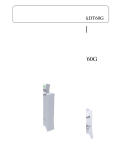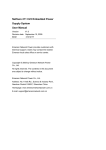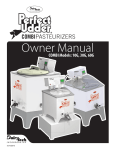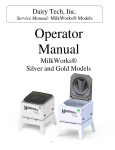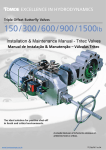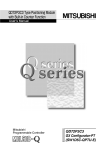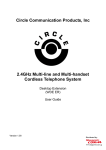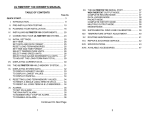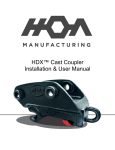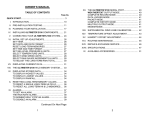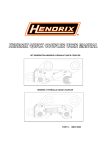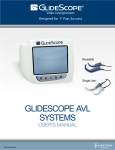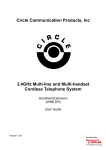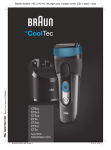Download owner manual DT series
Transcript
Dairy Tech, Inc. Service Manual: DT Series Operator Manual DT-Series MADE IN USA WWW.DAIRYTECHINC.COM 1 US Patent #6,276,264 Dairy Tech, Inc. Service Manual: DT Series Thank you for purchasing a Dairy Tech, Inc. DT Series Pasteurizer. Your satisfaction with this product is very important to us. This guide will help you understand how your pasteurizer operates, and how to get the most benefit from it for you and your dairy operation. Table of Contents: Introduction Important Disclaimers Table of Contents Welcome to Dairy Tech, Inc. Product Warranty Receiving your Pasteurizer Receiving your Pasteurizer Important safety instructions Diagrams (In back of Packet) Installation and Operation Installation Quick Guide Mounting the Control Board Water Supply and Connections Hand Winch Installation Electrical Requirements Initial Start-Up of the Unit System Operation Filling and Emptying the Milk Drum Delayed Start Feature/Clock Service Energy and Time saving tips Troubleshooting Guide When Service is Required THE DT SERIES PASTEURIZERS BE DONE ONLY BY QUALIFIED INDIVIDUALS. It is your responsibility or the responsibility of the electrician, plumber or other qualified installation expert to obtain all necessary permits and certifications required by your town, county, state or other jurisdiction before installation of the Pasteurizer. It is your responsibility to read and understand the operational requirements of the pasteurizer before using it and to observe all safety precautions. It is also your responsibility to see that your personnel are properly trained to operate and maintain the Pasteurizer. DAIRY TECH, INC. PROVIDES YOU WITH INSTRUCTIONS AND WARNINGS IN THIS USE AND CARE GUIDE, BUT WE ARE UNABLE TO COVER ALL POSSIBLE CONDITIONS AND SITUATIONS THAT MAY OCCUR IN YOUR DAIRY OPERATION. IT MUST BE UNDERSTOOD THAT COMMON SENSE, CAUTION AND CAREFULNESS ARE FACTORS WHICH CANNOT BE BUILT INTO THE PASTEURIZER. THESE FACTORS MUST BE SUPPLIED BY THE PERSON(S) INSTALLING, MAINTAINING OR OPERATING THE PASTEURIZER. Under no circumstances is Dairy Tech, Inc., its directors, officers, shareholders or employees responsible for damage to property or injury to persons or livestock resulting from the improper installation or use of the Pasteurizer. Installation by an unqualified individual and improper use and improper maintenance may also void any equipment warranty that Dairy Tech, Inc. offers. This use and care guide is based on information and data considered to be accurate; however, no warranty is expressed or implied regarding the accuracy of the information or data herein or the results to be obtained from the use of this data or information. THIS PASTEURIZER IS INTENDED TO BE USED IN THE MANNER DESCRIBED IN THIS USE AND CARE GUIDE. IT IS NOT INTENDED TO PASTEURIZE MILK FOR HUMAN CONSUMPTION. Please read this guide carefully and thoroughly before installing and operating this unit. Dairy Tech, Inc. has provided this use and care guide to assist you in the assembly, installation, and maintenance of your DT Series Batch Pasteurizer (the “Pasteurizer”). Serious injury and even death to persons and livestock can occur from improper installation and use of the Pasteurizer. Serious property damage can result from improper installation and use of the Pasteurizer. If you believe the pasteurizer is operating incorrectly, please refer to the trouble shooting guide included with these instructions before calling our service department. If you still have questions, contact a representative at 1-866-DTI-COWS and we will help you to address your needs. If your pasteurizer was purchased from and installed by an independent distributor, please contact the service department of that company for more convenient service. DAIRY TECH, INC. RECOMMENDS THAT INSTALLATION OF ANY ELECTRICAL, MECHANICAL, GAS OR PLUMBING DEVICES REQUIRED FOR THE INSTALLATION, OPERATION AND MAINTENANCE OF 2 Did you know? Dairy Tech, Inc. Service Manual: DT Series Dairy Tech, Inc. offers consultations with an independent Dairy Veterinarian at any time. If you have questions regarding calf health issues or other veterinary related topics, we would be glad to organize a conference call for you to discuss these. On site visits are also available to more thoroughly investigate any problems you may be encountering with calf health. For your safety, the recommendations and information in the manual must be followed to minimize the risk of serious burns or electrocution, as well as to prevent property damage, personal injury or death. We recommend professional installation by qualified plumbers and electricians familiar with such devices What to do if you are burned by the heating coil, hot water, steam or hot milk: Contact a physician or other medical personnel for expert advice, or go to an emergency treatment facility. Do not feed pasteurized milk to calves without first cooling it back down to a minimum of 110°F (43°C). Milk hotter than 110° can cause severe burns to the calves. Product Warranty This product is warranted to be free of manufacturing defects for up to30 months from the date of purchase, all parts will be covered by a free replacement guarantee. This warranty is intended for equipment in use under normal operating conditions and does not cover damages incurred by improper use. Determination of covered defects, damages or repairs is at the discretion of Dairy Tech, Inc. If you purchased this product directly from Dairy Tech, Inc., your product is covered from the date of your purchase for the full warranty period. If this product was purchased from a Distributor, be certain to call Dairy Tech, Inc. at 1-866-DTI-COWS to register within 10 days of purchase from the distributor. Failure to notify will result in the effective date of purchase being recorded as the date the distributor received the product into inventory. This warranty covers only the cost of replacement parts at Dairy Tech, Inc. current pricing. Service is not covered by this warranty. Receiving your pasteurizer 3 Use care when unpacking your DT Series pasteurizer. It will have arrived in two boxes. Please make a note of any cautionary labels that are used on the carton suggesting orientation, where to cut with a knife, fragile, etc. 1’x2’x4’ box: Contains the control board with the heater, controls, pump, valves, etc all pre-assembled. Carefully slide the unit from the end of the box and move to the location of the pasteurizer installation. 3’x3’x4.5’ box: The pasteurizing unit is typically shipped in the correct size drum to complement the system; however, the DT80, DT100 and DT150 will be shipped in a 55 gallon drum and the actual pasteurization drum will be shipped separately. Also found in this larger box will be two small boxes 6”x10”x12” marked A and B. Other loose items may include the optional wall mounting bracket if ordered, the adapting collar for larger systems, and the insulation wrap for around the drums. This white foam insulation will help to improve the heat efficiency of your pasteurizer and should not be discarded as packing material. Box A: winch handle, 900lb hand winch with bolts, winch mounting bracket, nut for mounting handle to the winch, 50’ poly rope, 2 split pulleys, instructions, accessory paperwork, rubber bands, one-page instructions in English and Spanish, tank adapter and ¾” tank spigot. Box B: Two hoses for connecting the cold water supply and draining, two hose washers and two screw-clamps. Important Safety Instructions Warning: To reduce the risk of electric shock, burns, serious injury or death to persons when using the Pasteurizer, follow these basic precautions: 1. 2. 3. 4. 5. Read all instructions before using the Pasteurizer. Always disconnect the electrical power before attempting service. Disconnect by grasping the plug, not the cord. Do not allow children to operate or play around the Pasteurizer. Close observation of children is necessary when the unit is used with children nearby. Do not reach into the Pasteurizer when the power is on and the paddle is turning. Hot Surfaces include the brass plumbing fixtures, electrical fixtures, hoses, heater body, heating coil, draining water and the milk or colostrum. Touching these surfaces during operation may result in severe burns. Dairy Tech, Inc. Service Manual: DT Series 6. 7. 8. 9. 10. 11. 12. 13. Do not try to change the settings in the pasteurizer controller without consulting a technical expert at Dairy Tech, Inc. Do not repair or replace any part of the Pasteurizer, or attempt any servicing unless specifically recommended in the trouble-shooting portion of this manual. Any modifications made to the unit beyond these instructions will void all warranties. Always clean the unit immediately after each use, according to the instructions in the “Cleaning of your Pasteurizer” section of this manual. Build up of residue on the coil or tank will decrease heating and cooling efficiency, as well as harbor potentially harmful pathogens. During the heating cycle, always make certain the Pasteurizer is firmly seated and centered on the drum of milk. Do not immerse the entire black unit into a drum of milk below the level of the top of the drum. Use the pasteurizer only for its intended purpose. DO NOT use for milk intended for human consumption as this product has not been approved for such use. Do not touch the heating coil, hoses or brass fittings while the unit is hot and working. Never stand under the unit while it is raised in the air. The Pasteurizer must be electrically grounded. DO NOT modify the plug that is provided with the Pasteurizer; if it will not fit the outlet, have an electrician install a proper electrical outlet. Installation: Warning: Install the unit according to the installation instructions. To reduce the risk of fire, electric shock, serious injury or death to persons, read the important safety instructions before operating this Pasteurizer. Before using this unit for the first time, wash out the inside of the drums and the external coil surface with hot soapy water and rinse clean. Criteria for Selecting a Location a) b) c) d) e) Choose a spot that will be protected from the elements. Extreme heat will allow milk spoilage and freezing temperatures will damage the unit. Ceiling height must be adequate to allow the unit to be raised above the height of the drum. 8’ ceilings are required for most units. Cold water is required to be connected to the unit, but hot water is also necessary for proper cleaning. Floor drains will allow for proper cleaning and rinsing of the product as well as to clean up milk spills. Power requirements are 115vac GFI for the control board and 220vac 40 amp for the heater. 4 f) g) h) i) Wall space for the control board is 2’ x 4’. Floor space requirements are approx that of a normal 55 gallon drum. When possible, position larger systems near the milk line so that it can be diverted directly into the tank while milking the sick cows or fresh cows. Avoiding extremely drafty areas will improve heating efficiency of the unit. Mounting the Control Panel The control board is supplied with all of the necessary pumps, valves and heaters pre-assembled for your convenience. The panel is 2’ x 4’ and should be bolted to the wall directly behind the location of the pasteurizing drum. Use the 8 holes that are provided in the back of the unit and hardware appropriate for the mounting surface. Position the panel at a height so that the operator can still reach the key pad. Connecting the Hoses HOT IN: This red hose (or marked with red tape) comes from the hot side of the electric water heater and enters the back of the pasteurizer to provide hot water for heating. This must be attached to the hose barb that is marked red. HOT OUT: This yellow hose (marked with yellow tape) returns warm water from the pasteurizer to the top of the pump and heater to be recirculated. Attach the hose to the barb that is marked yellow. COLD IN: This blue hose (or marked with blue tape) supplies all the cold water to the unit to charge the system for heating and to cool the product when finished. It can come from any cold water source including a hose but it MUST BE ON AT ALL TIMES DURING OPERATION. Using the supplied clamp, attach one end to barb on the side of the heater marked blue and the other end to the water supply. COLD OUT: This black hose takes cold water out of the unit once it has absorbed heat during the cooling cycle. It should be directed to a drain, cistern, stock tank or other collection system. Using the supplied clamp, connect one end to the hose barb to the left of the solenoid valve, with the other end free to flow. HAND WINCH, PULLEYS, AND WALL MOUNT BRACKET INSTALLATION * A wall mounting bracket is available for scenarios that do not provide an overhead anchoring point for the pulleys. It must be ordered separately. Dairy Tech, Inc. Service Manual: DT Series Hand Winch: this 900# hand winch comes with its own separate instructions that should be followed to prevent injury to the operator. A mounting bracket is included to mount the winch to the wall. For solid concrete walls, we recommend appropriate mollies or expansion bolts. For hollow block walls, all-thread bolts are recommended to penetrate the wall completely. Mount the winch at a height that allows for safe and comfortable use, within hands reach of the unit itself. This allows the operator to guide the unit into the drum of milk while lowering with the winch. **MAKE CERTAIN THAT THE LOCKING MECHANISM ON THE WINCH IS PROPERLY ENGAGED AT ALL TIMES AND REPLACE AT THE FIRST SIGN OF WEARING… NEVER ALLOW THE WINCH HANDLE TO SPIN FREELY WITHOUT THE HANDS-ON CONTROL OF THE OPERATOR** Electric winches and hoists are available. Call Dairy Tech, Inc. for a list of products and vendors. Pulleys: 2 split pulleys and a 50’ rope are included for properly attaching the unit to the winch. The pulleys should be positioned with one directly above the unit into the ceiling, the other attached to the back or side wall to guide the rope clear of the unit. The anchor points for the pulleys should be capable of withstanding 200# of weight. ***THE ROPE SHOULD BE CHECKED DAILY FOR SIGNS OF WEAR. IT CAN BE CUT AND ADJUSTED AS NEEDED … OR CALL FOR REPLACEMENT … SUBSTITUTION WILL VOID THE WARRANTY*** To attach the rope, securely fasten one end to the eyebolt on top of the unit and guide the other end through the two pulleys to the winch reel. Fasten to the winch according to the instructions and maintain excess rope length on the reel. Electrical Hook-Up Requirements The standard electrical cord emerging from the top of the control box should be plugged directly into a 115vac GFI receptacle on a 15amp breaker. Failure to meet these requirements will void the warranty and could result in serious damage to the unit, bodily injury or death. The receptacle should be fitted with a water resistant cover for added protection. • Be certain to use a GFI receptacle for the 115vac • The receptacle should be sharing minimal usage with other equipment to avoid unexpected outages and tripping. The Pasteurizer cycle will reset if the power is lost, but cannot reset if the breaker is tripped. • The 115vac breaker should be 15 amp. • DO NOT use an extension cord to operate the unit other than the one provided. 5 • Check your electrical system to make certain it is properly grounded to avoid the possibility of electrical shock. The 220vac supply for the electric heater emerges through the top of the control box. A 4’ length is supplied for termination into a junction box, or this cord may be removed and wired direct from the panel box by a certified electrician. The gauge of wire selected for L1 and L2 are very important and will depend on the distance from the panel box and expected amperage. The heater at full capacity will draw 37 amps on a single phase system. 40 amp breakers are sufficient in most instances. Some installations may require a 50 amp service, but always consult a certified electrician. The Pasteurizer is equipped with a cord having an equipment grounding conductor and a grounding plug. The plug must be plugged into an appropriate ground-fault outlet that is installed and grounded in accordance with all local codes and ordinances. DO NOT modify the plug provided with the Pasteurizer; if it will not fit the outlet, have a proper outlet installed by a qualified electrician. WARNING: DO NOT wire to 3 phase connections or 480vac. Pasteurizer controls are 115vac, 20 amp, 50-60Hz Heater is 220vac, 40 amp, single phase Final Connections: The last two connections to make are from the pasteurizer to the control box. The black power cord from the hood must be routed through the cord grip on the left side of the control cabinet. There are instructions in the wiring schematic for exact wire placement, as well as on an instruction sheet included with the pasteurizer. The thermocouple quick connection is located adjacent to that. The thermocouple cord has the appearance of a phone cord and plugs into the back of the pasteurizer on one end, and the left side of the control box on the other end. Failure to have this thermocouple cord properly plugged in will result in an Error on the display and the unit will not operate until the connection is made. Internal Fuse Board The unit is equipped with 8 fuses located inside the control box on the bottom edge of the electrical panel. The layout of the fuses is defined as follow: Dairy Tech, Inc. Service Manual: DT Series F1 F2 F3 F4 F5 F6 F7 F8 Main Transformer Pump Motor cold ctrl Hot Valve Cold Valve cold ctrl 20amp 1amp 2amp 10amp 1amp 1amp 1amp 1amp The display will indicate the temperature, Initial Start-up of the Unit (Pressurizing the System) After making all the proper plumbing and electrical connections, pressurize the system by turning on the cold water supply. (Purging the Air) Air is purged out of the system by two means: The pressure relief valve on top of the heater can be opened to allow water to flow through and force out air pockets trapped in the system. Likewise, the small red cap on top of the air vent can be opened to allow air and vapor to escape the system. Failure to remove all of the air from the system could result in severe damage to the heating elements in the heater, and could also prevent the pump from working to circulate the hot water properly. Use of the Pasteurizer The unit is now ready for milk or colostrum to be added for pasteurization, but first properly clean the drum and coils to remove oil residues from manufacturing. Simply fill the drum that was included with your system and lower the pasteurizer completely onto the drum using the hand winch provided. The drum must be filled to a level that allows the thermocouple, propeller and heating coil to be immersed in the product for even heating and process control. If the volume is inadequate, there will be uneven heating and possible errant temperature readings by the thermocouple system. Switch to a smaller drum to achieve the desired conditions. It is also important to not overfill the drum as it will leak over the sides while stirring once the unit is lowered. Time & Temp for proper pasteurization: Milk 145°F(63°C)/30 minutes or 161°F(72°C)/30 seconds Colostrum 140°F (60°C)/ 60 minutes To STOP Pasteurizer cycle: Pause by pressing the button used to start the cycle (Start, Heat Only or Cool Only), or flip the toggle switch off, or unplug the unit from the receptacle. To restart from the Pause position, simply press the same button again and the cycle will resume. Only use the “Cool Only” button to restart if you are certain that the product was fully pasteurized. DELAYED START Running the Cycles stage of cycle and TIME to complete the current cycle. HEAT ONLY is depressed if only the heating portion of the pasteurization process is desired. The milk will not cool down at the end of the timing. The display will indicate temperature and time, and “END” when complete. COOL ONLY is depressed when the milk has already been pasteurized completely, but is not yet cool enough to feed or handle. The display will indicate temperature and then “END” when complete. UP and DOWN keys are used during programming or alterations to the settings. AUXILARY / INTERRUPT is used only for reheating the milk if it needs to be warmed for feeding. An alarm will beep several times at the end of a completed cycle, and the display will indicate “END”. If the cycle has not completed properly within a preset window of time, the alarm will beep continuously and indicate an “ERROR” in the display. If the display indicates other “ERRORS” with associated numbers, refer to the troubleshooting guide for further assistance. To power down the unit, turn off the red toggle switch or unplug the unit from the wall. The unit should be toggled off after the completion of each cycle, unless set for a delayed start. If the unit is powered off before completion of a cycle, it will attempt to resume that cycle when power is restored. To shut down during a cycle, press the button that was used to initiate the cycle and hold it for 3 seconds. The display will indicate PAUSE, but continue to hold until it displays “IDLE”. Now the unit can be powered off. a. Power the unit on by toggling the red rocker switch; the display should indicate “IDLE”. START is used to initiate a complete heat/cool cycle. Press twice for immediate start Instructions for delayed functions follow here. 6 b. Press either the START, HEAT ONLY , COOL ONLY, or AUX button so that the word “NOW” is displayed. Then press the UP key to scroll through the options of Delay1, Delay2 or NOW. Dairy Tech, Inc. Service Manual: DT Series c. d. e. Then press the START key once again and the clock will appear. Use the UP or DOWN button to adjust the time for delay. Once the time is set, press START again and the screen will again display “Delay1” or “Delay2” and will wait for that time to start the cycle. The unit will now come on at the time you have set. SETTING THE CLOCK Power the unit on so that “IDLE” is displayed on the screen of the controller. Depress the START and AUX buttons at the same time and hold for several seconds. The real time clock will be displayed. Use the UP or DOWN buttons to change the time. Depress the HEAT ONLY button to accept the changes and return to the “IDLE” mode. Warning: The heating coil can cause severe burns if handled before it is completely cooled. Always finish the cooling cycle before handling the milk. Grasp the unit by the plastic top if it is still hot to the touch. There area variety of ways and means to fill the drum for pasteurization. Ideally, the unit is situated near the main milk line so that a break can be made to divert the waste milk directly into the unit. The product can also be bucketed into the drum, or pumped in from another station with sump pumps or the like. Energy and Time Saving Tips • With the unit powered OFF, raise the pasteurizer hood from the drum of milk using the supplied winch. Make certain the locking mechanism has locked before releasing the handle. • HINT: Cut the top off of an old 55 gallon used drum, and then cut the front side out of it so that the unit can be lowered onto this “Wash Drum” for thorough cleaning without the mess. Filling and Emptying the Milk Drum To remove the milk: A spigot is included with all systems to install at the bottom, side of the tank. This can be used to fill buckets or bottles directly. A stainless steel sump pump can also be used to pump the milk more aggressively onto a calf cart or other feeding equipment. Larger bore drains are also available for installation into the side of the tank. CLEANING THE SYSTEM (be sure the equipment is powered OFF) surface areas with a soapy rag or mild abrasive pad to remove excess residue on the following components: stainless steel coil propeller and shaft thermocouple probe underside plate of the pasteurizing hood drum accessory spigots or hoses Stubborn residues may be cleaned with a scour sponge and approved milk acids if necessary. Follow manufacturers handling recommendations for all chemicals. Clean the following milk surfaces with hot water and an appropriate disinfectant. Go over all the exposed • • Pasteurize the milk as quickly as possible after collection to take advantage of the heat already in the milk to improve energy efficiency. This will also prevent the immediate heavy growth of bacteria in this fresh product. Avoid placing the unit in an area of high drafts to prevent convection heat losses from the drums while pasteurizing. Wrap the drums with the included ½” insulating foam that comes with them. This foam has an insulating value which can be very helpful in preventing heat loss. To be most efficient, choose the proper size DT Series Pasteurizer for your operation. When Service is Required If you purchased the Pasteurizer from an authorized dealer, contact them directly with inquiries or repair questions. For prompt service, work through the troubleshooting guide in this manual to give an accurate description of the problem. Assistance is also available on-line at www.dairytechinc.com. Repair by an unauthorized service provider will void the warranty. 7 Dairy Tech, Inc. Service Manual: DT Series Trouble Shooting Guide DT Series Pasteurizers *This guide is intended for use as a troubleshooting directive. All electrical tests and diagnostics should be performed only by those skilled in the electrical profession* *All electrical testing and repairs should be performed by an experienced professional or technician trained in the electrical trade* *Serious injury or death may result from improperly testing or handling this equipment* *This unit contains HIGH VOLTAGE electricity that can cause serious harm or death* 1. No power to the control panel a. Check to be certain unit is plugged into 120vac outlet and that there is power at the outlet. b. Be certain that breakers in panel box or ground fault receptacle are not tripped i. If the breakers are being tripped, the system is likely being shorted to ground. Look for any blown fuses to indicate trouble areas and consult the fuse layout for more detail. Have the system checked by a certified electrician before operating. c. Check the 15amp fuse (F1). Make sure there is 115vac to and through the fuse. If not, replace with appropriate fuse. DO NOT REPLACE WITH OVERSIZED FUSES. (Part # AE-Fuse) d. Check the rocker switch to see if it is lit when switched on. This should indicate that power is getting to the switch. If there is not 115vac leaving the switch through the black/yellow wire when switched on, the switch may need replaced (Part# E-Switch) e. Check the transformer (TX1) for proper voltages. The purple and grey wires should carry a 24-32VAC signal to the control. The black/white and white/black wires carry the 115VAC supply to the transformer. (Part# AE-TXFR) f. On the back of the control, make certain that the orange 15pt plug is securely plugged into the receptacle on the back of the controller. g. The control is fused (F2) between the transformer and the control. Check the appropriate fuse to make sure power is getting to the control. 8 Dairy Tech, Inc. Service Manual: DT Series h. The control (Part # E-Control) itself could be malfunctioning or internally damaged. This is only rarely seen. Call for assistance. 2. Milk does not heat and the heater is not hot. a. Is there power getting to the pasteurizer heater? Check the incoming voltage to the contactor through L1 and L3. There should be 120vac on each line coming in. If not, check the breaker. The breaker should be 40 amp but in some instances with 240vac and long runs to the unit, a 50 amp service may be required or an upgrade to heavier gauge wire. Contact an electrician. b. Is there power getting to the heater? Initiate a cycle and the contactor should make a loud “click” as it activates. Check to see if the 220-240vac is getting through the contactor and out of L1 and L3 on the bottom. If not, the contactor may need replaced. i. If the contactor does not click, check the 115vac leads (brown/white and white/ orange wires) on the back top of the contactor to see if it is being signaled by the SS relay. If there is 115vac signal, replace the contactor (Part# E-Contact) ii. If no 115vac signal to the contactor, check the solid state relay SSR2. There should be a D/C signal though the yellow and orange colored wires to the relay and the LED should be lit when activated. 115vac is supplied to the relay through the black/yellow wire. Once signaled, there should be 115vac out of the black/white wire to the contactor. If not, replace the SSR2 (Part # AE-RelaySS) iii. No D/C signal to the SSR2. Check the fuses for the control (F5 and F8). Check the orange plug on the back of the control. Call for service as the control output may be damaged and need replaced. (Part# E-Control) c. 240vac is getting to the heating element but still no heat …. Remove the red or orange cap from the bottom of the heater and check for continuity across the elements. If you have an element with redundant sets of elements, rewire a new element or order a replacement heating element (Part # E-HeatX). 3. Milk does not get hot but Heater is hot. a. Some old units have a solenoid valve on the top row of brass with a blue body. This hot water solenoid valve must open to allow hot water to flow. Check it for power or call for instructions to remove this valve and instructions to reroute the plumbing on the heater. b. Pump must be working to circulate the hot water. i. Check for power inside the control box at the terminal strips. If there is power to the pump but it is not flowing, the pump may be air-locked (carefully open the pop-off valve on the heater to allow any air out of the system) or the pump may be bound by debris (relieve water pressure and open the body of the pump to check the blades for free movement). If the pump turbine does not spin when powered, replace. (Part# P-Pump.) 9 Dairy Tech, Inc. Service Manual: DT Series ii. No power getting to the pump during a heating cycle: check the fuse in the control panel box marked pump (F4) and replace if necessary. (Part#-AE-Fuse) iii. No power to the fuse holder during a heating cycle: Check the cube relay CR1. There should be 115vac coming into the top of the CR1 through the black/ orange wire at all times. The brown wire brings the 115vac signal from the control to activate the relay to allow 115vac out the bottom of CR1 through the black/red wire to the valve fuse (F6), and through the black/brown wire to the pump fuse (F4). If no power to the brown wire, check the control fuse marked hot (F3). The output of the control may be damaged and need replacement (Part# E-Control). If there is a proper 115vac signal, the relay or relay base may need replaced. (Part# E-relay8 or E-relaybase) c. Milk level is not high enough. The thermocouple needs to be immersed into the milk otherwise it will read foam temperatures which are cooler and not allow the control to know that the milk is heating. d. Heating coil is caked with milk. This prevents the heat from dispersing out of the coil and caused further baking of the milk onto the coil. Remove from the milk, shut the machine off and clean thoroughly. Some non-stick cooking sprays can be used after cleaning to prevent sticking if it is a problem. e. Cold water is coming into the system. If there is a leak in the system, a leaking pop-off valve or a leaking cold water solenoid valve, the heater cannot keep up and the milk will not heat properly. Repair the leak or replace the valve (Part # P-ValRel) or the solenoid valve (Part# P-Val2psi). f. Red or yellow hose is kinked inside the hood preventing hot water circulation. 4. Milk will not cool a. At the end of the heating and time-out cycle, the cooling solenoid valve should automatically open and allow water to drain from the machine. i. Make certain the discharge drain is not blocked, kinked or obstructed with back pressure of any kind ii. Make certain the cold water supply to the unit is always on … it is common to find that someone has shut the valve not knowing its importance. iii. Make certain that the user did not initiate a “Heat Only” cycle after which the unit does not cool the milk automatically. Use the “Start” button to initiate full cycles. b. Check the cold (black bodied) solenoid valve. The thermocouple temperature must be above 100F or above your coolT setting in the control for the cycle to initiate. i. Is there power to the valve? If so, and it is not opening, replace the valve. (Part# P-Val2psi) 10 Dairy Tech, Inc. Service Manual: DT Series ii. No power to the valve: Check the fuse marked Cold valve (F7). Replace if necessary and check for power to the fuse from the cube relay CR2 via the blue/ white wire. There should be 115vac power supply to the top of the CR2 through the black/orange wire. The 115vac signal from the control comes through the blue wire to open the relay. If the relay is powered, replace the relay or the base of the relay. (Part# E-relay8 or E-relaybase) iii. If there is no 115vac signal to the relay from the blue wire, check the cold control fuse (F8) or the output from the control may be malfunctioning (Part# Econtrol) 5. Error message appears: The display is on but is flashing an Error message. a. Check to make certain that the thermocouple retractable cord is plugged into the female outlets on the pasteurizer lid and the control box. There may also be corrosion at a terminal, or a break in continuity of the thermocouple system that is causing the error. b. If it shows only “ERROR” without a number, the unit has exceeded the set amount of time it thinks is required to complete the cycle and is indicating that the process should be monitored for problems. This setting is labeled “terr” in the E-type submenu of the controller and will likely be set for 3-5 hours depending on the unit size and whether refrigerated or not. c. Error codes i. Error 1, Error 2 or Error 3: controller malfunction. Cycle the power off and then back on. IF the error persists, return the controller for replacement. The system may be too cold to operate. ii. Error 4: calibration error in the controller. Return the controller for recalibration or replacement. iii. Error 5 and Error 7: temperature sensor input 1 (milk) is incompatible with the controller, has lead wires improperly terminated (leads switched at the terminal) or is measuring a condition below the normal temperature range. Check the lead wires for t/c 1 and check the controller for proper t/c selection and parameters. Check all t/c connections to make certain they are making a good connection. See thermocouple diagnostics below for more information and troubleshooting procedures. Error 6 and Error 8: temperature sensor input 1 (milk) is incompatible with the controller, has lead wires improperly terminated (leads switched at the terminal) or is measuring a condition above the normal temperature range. Check the lead wires for t/c 1 and check the controller for proper t/c selection and parameters. Check all t/c connections to make certain 11 Dairy Tech, Inc. Service Manual: DT Series they are making a good connection. See thermocouple diagnostics below for more information and troubleshooting procedures. iv. Error 9 and Error 11: temperature sensor input 2 (heater) is incompatible with the controller, has lead wires improperly terminated (leads switched at the terminal) or is measuring a condition below the normal temperature range. Check the lead wires for t/c 2 and check the controller for proper t/c selection and parameters. Check all t/c connections to make certain they are making a good connection. The system may be too cold to operate. v. Error 10 and Error 12: temperature sensor input 2 (heater) is incompatible with the controller, has lead wires improperly terminated (leads switched at the terminal) or is measuring a condition above the normal temperature range. Check the lead wires for t/c 2 and check the controller for proper t/c selection and parameters. Check all t/c connections to make certain they are making a good connection. vi. Error 13: ambient temperature around the equipment is too high or too low. vii. Error 14: Real time clock error. Not a fatal error but may need replaced if the clock is not able to be used properly for delayed start function. 6. Temperature Display is erratic or incorrect. a. Troubleshooting the thermocouple system b. The thermocouples are polar sensitive and will yield erratic numbers or even move down in temp when the process is heating. The unit may also flash an unusually high number and then immediately indicate END or begin to countdown because the unit thinks it has reached temperature. Make certain that purple or white leads are positive (+) and red leads are negative (-) at all junctions. c. The thermocouple rod itself could be damaged or kinked. To test this, unplug the retractable cord from the back of the black hood. Hold the two prongs of the cord end against a copper pipe to jumper them together. If this makes the error go away, the problem is with the thermocouple itself. (Part # E-therm24) d. The retractable thermocouple cord could be damaged. To test this, unplug the cord as it inters into the bottom or side of the control box on the wall. Make a u-shaped jumper with a paperclip and insert it into the plug. If the error goes away, the problem is either in the retractable cord (Part # E-tcRSC-E-3-4-4) or in the thermocouple probe (see above). e. The controller may be programmed to read the wrong type of thermocouple. (This condition may allow the unit to operate but at temperatures that are different than what is displayed … cross reference with a second thermometer if concerned about this rare occurrence and contact your dealer immediately to reprogram the control). 7. Milk is separated or congealed 12 Dairy Tech, Inc. Service Manual: DT Series a. The most common cause for milk or colostrum to separate or congeal is acidification of the milk caused by two processes: i. Fermentation of the milk by bacteria will cause the release of lactic acid and other acidic by-products resulting in a lower pH of the milk. This in turn allows it to separate. The heat of pasteurization will exacerbate this problem. To control this, cool the milk during holding stages or pasteurize the milk sooner after collection to prevent the start of fermentation. ii. Acidic cleaners are not being rinsed from the system. Rinse properly before each use. Do not use acids to clean the aluminum parts as this can cause severe damage to the tanks and pose a safety risk for the employees. b. Thickened milk or colostrum that is stuck to the tank or heating coil may be due to: i. Improper stirring (make certain the propeller is moving during heating, time out and cooling cycles) ii. Temperatures that are too high (rarely a problem since our units cannot superheat water). 8. Stir motor is not turning a. Check the fuse for the motor F5 (Part# E-fuse10) b. If the fuse is good, make certain that the wire to the motor has not been damaged or pulled out of the unit. c. If there is power to the motor and it will not turn, replace the motor (Part# E-motor) d. If there is no power to the motor, check the solid state relay SSR1. During heating, timing or cooling cycles, the red LED should be on at this relay indicating power from the controller. If this light is not on, check for a DC signal from the controller and check fuses to the control. The output from the control may be malfunctioning, replace the control (Part# E-control). e. If 115VAC power comes into the SSR1 through the black/grey wire but does not go out through the black/green wire when the LED is on, replace the relay (Part # e-relaySS) 9. Delay start does not come on automatically a. Check the clock settings to make certain that the time of day is set correctly b. Make certain that the steps for using the delay start are being followed exactly. The start button should be pushed 3 times to set the delay start mode. c. The control output could be damaged. (Part# E-control) 10. Cycle starts automatically when toggle is switched on a. Your pasteurizer is equipped with a security feature that reminds it to come back on to its last unfinished cycle once power is restored after a power failure. This will also occur if someone shuts the unit off prior to completion of its assigned cycles, and the unit will automatically restart when the toggle switch or power is restored. To reset to 13 Dairy Tech, Inc. Service Manual: DT Series IDLE, hold the START, HEAT ONLY, or COOL ONLY (whichever button is lit) button in for 3 seconds … let it go to pause and continue to hold in until back to IDLE. 11. Pressure relief valve is dripping a. Occasionally, these valves may start to leak, especially if they have popped off under pressure a few times. They should be replaced with an industrial pressure relief valve rated for the same temperature, pressure and BTU rating (Part # P-valRel). 12. Cooling solenoid valve will not stop running a. Shut off cold water supply and remove the 4 bolts into the body of the solenoid valve. Check for debris that may be preventing the diaphragm of the valve from reseating properly. b. The valve may need to be replaced if it is powering properly but not closing when the solenoid closes (Part # P-val2PSI) 13. Fuse and electrical schematic a. F1 Main power supply 115vac 15A Part# E-fuse15 b. F2 Transformer 1A Part# E-fuse1 c. F3 Pump 2A Part# E-fuse2 d. F4 Motor 10A Part# E-fuse10 e. F5 cold control 1A Part# E-fuse1 f. F6 Hot valve 1A Part# E-fuse1 g. F7 Cold Valve 1A Part# E-fuse1 h. F8 Hot Control 1A Part# E-fuse1 14. Replacement part list and ordering form … www.dairytechinc.com 14 Dairy Tech, Inc. Service Manual: DT Series Assessing controller function *** IMPORTANT WARNING*** DO NOT ALTER SETTINGS IN THE CONTROLLER WITHOUT CONSULTING A DAIRY TECH REPRESENTATIVE …. ANY UNAUTHORIZED ADJUSTMENTS WILL VOID THE PRODUCT WARRANTY AND MAY LEAD TO SERIOUS HEALTH CONSEQUENCES FOR THE CALVES. To access the controller main menu for milk/heater temperature settings as well as process timing, follow these steps: Instructions for setting the Dairy Tech LP Series controller functions: Number the keypad buttons across the top then bottom from left to right 123 456 1. 2. 3. 4. 5. 6. 7. 8. 9. Turn power on to the display so that it reads IDLE. Press and hold 3 and 6 for 3 seconds until straight lines appear across the screen. Press and hold 4 and 5 for 3 seconds to get into the menu screen .. eType should appear on the screen. Press 1 to go into this menu. DO NOT go into other menus. Use 3 and 6 to toggle up and down thru this menu. The code and its numeric value will flash back and forth between each other. The following 5 parameters are set here: a. Setpt – pasteurization temperature to reach b. Coolt – temperature milk will cool to c. Mntr – maximum temperature of heater d. tHeat – length of time at Setpt temperature e. terr - time allotted for complete cycle before alarm sounds Press 1 to select a parameter to change; the numeric value will be displayed. Press 3 or 6 to raise or lower the value. Press 2 to accept the change ... repeat steps 6-8 for any other changes. Press 2 repeatedly until you are back to the idle screen and the changes should have been accepted. Pasteurize Profile Starting the Profile The Pasteurize Profile can run three different modes, Full Mode, Heat Only Mode, and the Cool Only Mode. Each of these modes can be started immediately or set to start at a programmed time. When the initial key is pressed (see description below) the display reads nOW. If the same initial key is pressed, the selected mode will start immediately. At the nOW display, the increment and decrement keys can be used to select between nOW and dELAy. Initially at the dELAy display, 15 Dairy Tech, Inc. Service Manual: DT Series if the same initial key is pressed, 12:00AM time will be displayed. The user may set the starting time by using the increment and decrement keys to adjust the time. When the same initial key is pressed, the control will remain in the Idle State (the display will now read dSTrt), but will start the appropriate mode of the Pasteurize Profile at the time selected. This delay time will be used only once. A user must set the delay time before each delayed start. Using the Start key (Key A) as described above will select the Pasteurize Profile in the Full Mode. When the Full Mode starts, the Pasteurize Profile will execute both the Heat Stage and the Cool Stage (first the Heat Stage and once it completes, the Cool Stage will begin). Using the Heat Only key (Key B) as described above will select the Pasteurize Profile in the Heat Only Mode. When the Heat Only Mode starts, the Pasteurize Profile will execute only the Heat Stage. Using the Cool Only key (Key E) as described above will select the Pasteurize Profile in the Cool Only Mode. When the Cool Only Mode starts, the Pasteurize Profile will execute only the Cool Stage. Heat Stage When the Heat Stage is initiated, the heater (Output 1) is enabled to control heat to the setpoint (setpt parameter in the Equipment Type Submenu), the cooler (Output 2) will turn continuously off, and the motor (Output 3) will turn continuously on. Once the heater temperature sensor (Sensor Input 1) value becomes greater than or equal to the setpoint (Setpt parameter in the Equipment Type Submenu), an internal timer is started. The internal timer will be set to expire in a time interval equal to the theat parameter in the Equipment Type Submenu. Once the internal timer expires and if the Start key (Key A) was used to start the profile, the Cool Stage will begin. Else if when the internal timer expires and the Heat Only key (Key B) was used to start the profile, the profile will be completed. Cool Stage When the Cool Stage is initiated, the heater (Output 1) is disabled from controlling heat, and the cooler (Output 2) and the motor (Output 3) will turn continuously on. Once the heater temperature sensor (Sensor Input 1) value becomes less than or equal to the cool setpoint (Coolt parameter in the Equipment Type Submenu), the cooler (Output 2) and the motor (Output 3) will turn continuously off, and the profile will be completed. Pausing the Profile If the Pasteurize Profile is in the Full Mode, a single press of the Start key (Key A) will pause the profile. An additional press of the Start key (Key A) will resume the profile running. If the Pasteurize Profile is in the Heat Only Mode, a single press of the Heat Only key (Key B) will pause the profile. An additional press of the Heat Only key (Key B) will resume the profile running. If the Pasteurize Profile is in the Cool Only Mode, a single press of the Cool Only key (Key E) will pause the profile. An additional press of the Cool Only key (Key E) will resume the profile running. Canceling the Profile If the Pasteurize Profile is in the Full Mode, pressing and holding the Start key (Key A) for 3 seconds will cancel the profile. If the Pasteurize Profile is in the Heat Only Mode, pressing and holding the Heat Only key (Key B) for 3 seconds will cancel the profile. If the Pasteurize Profile is in the Cool Only Mode, pressing and holding the Cool Only key (Key E) for 3 seconds will cancel the profile. Contact Dairy Tech, Inc. Dairy Tech, Inc. 16 Dairy Tech, Inc. Service Manual: DT Series 405 Tuckaway Ct Windsor, CO 80550 Phone: 1-866-384-2697 1-970-674-1888 1-970-686-5871 fax Monday – Friday 7:00 a.m. – 6:00 p.m., MST Web: www.dairytech.org 17

















